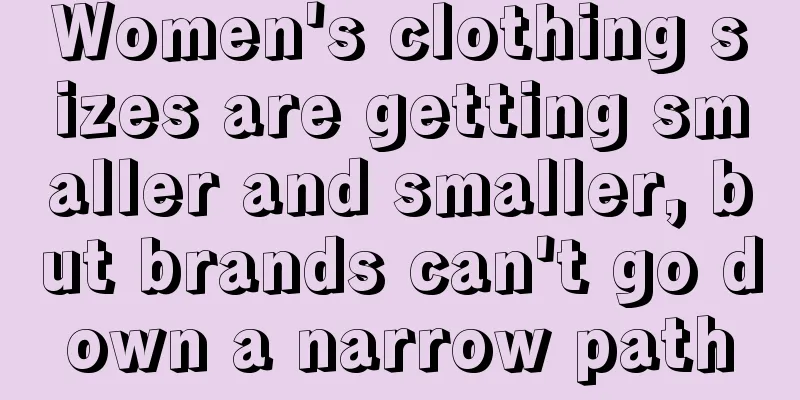Women's clothing sizes are getting smaller and smaller, but brands can't go down a narrow path

My first reaction was that I had gained weight, but when I looked at the size chart, I realized that the waist circumference of the L size clothes was only 65. I looked at the M and S sizes again, and they were only 62 and 59. Wasn't this really children's clothing? I don't know when it started, but women's clothing has become smaller and smaller. I went from M to L, and now I can't even wear L. There is a suggestion online for single women: hang a few men's T-shirts on the balcony to pretend that there is a man at home. I don't think it's necessary. Now when I look at my balcony, I just think there are many children in my house. I admit that everything exists for a reason. Small-sized women's clothing can become popular because users have demand for it and merchants can make money. BM, a women's clothing brand that only sells small sizes, was originally designed to meet the needs of some petite girls who could not wear ordinary sizes. Later, it attracted some negative reviews because it over-advertised thinness as beauty in its marketing and led people to compare body shapes. Rather than why small-sized women's clothing is so popular, what I want to ask is, why, even though we have been encouraging diverse aesthetics for so many years, large-sized women's clothing is still unpopular? Looking at the global fashion industry, plus-size is actually the mainstream trend. While overseas brands are already using plus-size models and KOLs to express diverse aesthetics, most domestic brands are still touting the "white, young and thin" aesthetic, and the anchors in the live broadcast room all weigh less than 100 pounds. I think girls should all know that small size is an option, not a standard. But when I see the slender figure of the model in the video, I still can't help but complain about why I can't be thinner. When we ask “Why are women’s clothing becoming smaller and smaller?”, we are actually asking “Have I really accepted my own imperfections?” For brands, this question is a choice between “short-term harvest” and “long-term construction”. 1. If you want to wear normal-sized clothes, please stop "self-PUA" firstIn the past two years, even Uniqlo stores, which have always been comfortable, are full of short gyaru outfits, and gyaru-style women's clothing brands such as Chuu have also emerged. After opening its first store in the Chinese market in 2021, Chuu opened 156 stores in less than two years and is still expanding rapidly. Business is profit-driven, and there is a market only when there is demand. Brands are competing to launch small-size women's clothing, which shows that girls still want to lose weight, and they will unconsciously fall into "self-PUA" when consuming. This made me realize that although some brands have been promoting aesthetic diversity and inclusiveness in recent years and encouraging women to accept themselves, it is far from enough. The lingerie industry was one of the first to subvert traditional aesthetics. About 10 years ago, a number of brands emerged, such as NEIWAI and Ubras, which focused on comfort and redefined sexiness as real and free. In 2020, NEIWAI released a spring and summer blockbuster with the theme of "NO BODY IS NOBODY", which lasted for three years. This project sparked a large-scale discussion in the marketing circle at the time and is still talked about today because it broke people's inherent impression of underwear advertisements and let a group of ordinary people with fat, flat chests, old age and scars be models to express that "no body shape is insignificant" and encourage women to accept themselves. On Women's Day this year, NEIWAI launched a new women's marketing campaign "Ten Questions About the Body". In a more powerful way, it responds to the doubts, confusions, confusions, and contradictions about women's bodies... Such brand marketing has awakened the self-awareness of some women and shown them another option. But we have awakened, but not completely. Although I say I disdain the aesthetic of being thin, young, and fair and reject body anxiety, I secretly envy the so-called "girl group body". When I open social networks, I see hot girls and pure lustful girls every day, and then I look at my arms with arm fat, so I put the suspenders I just bought aside. Because I couldn't fit into small-sized clothes, I once fell into self-PUA: Is it because my figure is not good enough? Is being thin normal? No, it's because we have been controlled by secular aesthetic prejudices for too long. When we take the step of change, we will inevitably fall into self-doubt. Being white, young and thin are rare genes in nature. Because of their scarcity, ordinary people can hardly have them, so they are suitable for creating anxiety. And anxiety means consumer demand. In this business chain, the demand side and the supply side form a closed loop. The company that is most skilled in using this user insight is BM. Its product positioning is to only sell small-sized women's clothing, and its promotional method is to induce girls to compare their figures. On social networks, girls are proud to be able to fit into BM's clothes. If they can be selected as a BM clerk, it is a recognition of their figure and appearance. Small-sized women's clothing is not a sin in itself. Suspenders or tights are just decorations for women to show their beautiful side. What we need to accept is actually the contradiction in our hearts, and we believe from the bottom of our hearts that suspenders can be sexy even if you have meat. 2. Why is no one willing to make plus-size women's clothing?There is demand for small-sized women's clothing, and there is also demand for large-sized women's clothing. And judging by the proportion of the population, the demand for large-sized women's clothing may be even greater. Why is large-sized women's clothing not popular? Doris Dao once recorded a podcast with Dabai, the founder of the large-cup underwear brand Naitangpai. He mentioned that large-cup underwear is a bitter and difficult business, so no one is willing to do it. The bitterness lies in the lack of standardization of the supply chain and the difficulty in opening up the market demand. The reason why everyone makes small-sized women's clothing is that there is a large demand from consumers, and also because small-sized women's clothing has relatively low requirements for the supply chain. Most of the small-sized women's clothing on the market are basic T-shirts and suspenders. On the one hand, it saves fabric costs, and on the other hand, the simple style and compressed size can greatly reduce inventory pressure. After all, the difference between S/M/L sizes is so small that it is almost invisible to the naked eye. The reluctance to make plus-size women's clothing is also due to insufficient motivation on both the demand and supply sides. The flip side of thinness being beautiful is being ashamed of being fat. Users of plus-size women's clothing tend to use loose clothes to cover their bodies, and rarely think seriously about what style suits them. Without clear user needs, it is difficult for brands to figure out the real needs. On the supply chain side, the cost of plus-size women's clothing is also higher. Take Naitangpai as an example. Large cup bras are targeted at a niche group of people, and the market space is relatively limited. However, within the limited population demand, the SKU is very long-tailed, from C cup to K cup. The more extreme the size, the more difficult it is to develop, and the smaller the demand. This means that some products are destined to not make money. For example, traditional bras come in about 9 to 12 sizes, and each size can be mass-produced. But Naitangpai has to make more than 30 sizes, divided into three types of breast shapes, each in two colors, and the order volume for each type is not large, which can be said to be a thankless task. Dabai said that every time he looked for suppliers, the other party's eyes were wide open, and he finally visited dozens of companies before finding one willing to cooperate. Even if the supply chain problem is solved, large-size women's clothing is more likely to have inventory backlogs due to too many SKUs. You should know that inventory consumes not only production costs and raw material costs, but also warehouse rent, logistics costs, discount losses, labor costs, inventory insurance, etc. It also occupies working capital, increases operating costs and risks, and once the inventory is too large, it may even cut off cash flow. Whether it is an online store or a physical store, inventory is a long-standing problem. Especially in recent years, offline store sales have been affected by force majeure, and the return rate of online sales has remained high, bringing greater pressure to the entire industry. Clothing brands that have seen declining performance in the past two years have generally had high inventory levels. For example, PEACEBIRD once relied on a large number of IP co-branded items to stimulate sales. However, the rapid launch of new products has also led to an accelerated expansion of the SKU base. Although there are popular items, more unsalable items have become backlogs of inventory. A look at PEACEBIRD's financial report shows that its inventory has been rising since 2011, when it was 664 million yuan, and reached a peak of 2.54 billion yuan in 2021, accounting for more than 23% of that year's revenue. Even mature brands are troubled by inventory, not to mention a large number of new brands and white-label brands. They lack sufficient digital capabilities to fill the information gap between the production and sales ends. Following the trend will only lead to more and more inventory. Dabai's experience may be just a microcosm of countless people who make plus-size clothing brands. Fortunately, he found a way out after exploring for the past few years. 3. The Victoria's Secrets who became plus-sized have all tasted the sweetnessIn 2018, Naitangpai launched a new product, "Marshmallow", which is a double-strap, anti-bump, ultra-thin 3/4 cup bra that makes big breasts look smaller. This product sold about 1,500 pieces within 4 hours of its launch, which was an exciting achievement for Naitangpai, which was very small at the time. Naitang Pie found a breakthrough from both the demand and supply chain ends. On the demand side, Naitangpai uses the "product community" to find users' needs and pain points, and creates products with them. On the supply chain side, it uses a stupid method: trying and grinding one by one. In order to develop strapless bras suitable for large breasts, Naitangpai spent a full three years. It may not be a cost-effective investment in the short term, but in the process of product development and listing, the positive connection established between the brand and users can bring longer-term and healthy benefits. If we look overseas, we will find that plus-size women's clothing has become a mainstream trend. First of all, from a cultural perspective, we can see that in recent years, more and more film and television works have expressed the female perspective. Culture and art awaken people's consciousness, and the awakening of consciousness gives rise to new demands, and user demands drive business decisions. It is only a matter of time before the plus-size trend blows to China. Moreover, the ceiling of a brand that becomes popular by wearing gyaru and girl group style is very low. Because adult women with a waist circumference of 59 are a minority. Excessive promotion of thinness and body anxiety will bring negative effects to the brand. Complaints about women's clothing sizes have been overwhelming on social networks. Many girls with "average figures" cannot buy clothes. Paying attention to and meeting their needs is the opportunity for brand marketing and business growth. A classic example of a brand that has turned around by encouraging diverse aesthetics is Victoria's Secret. Yes, the same brand that was once known for its sexy lingerie and was criticized for pleasing men. On June 1 this year, Victoria's Secret released its first quarter financial report for 2023: net sales were US$1.407 billion, adjusted operating income was US$55 million, and adjusted net income was US$22 million. Among them, Victoria's Secret China's performance turned losses into profits - in the 2020-2021 fiscal year, Victoria's Secret lost HK$669 million and HK$109 million in China respectively. During the 618 shopping festival this year, Victoria's Secret achieved sales of over 32 million yuan, a year-on-year increase of 216%, ranking top 3 in the women's underwear and home wear categories on Tmall. All these achievements are due to Victoria's Secret's transformation in user insights, products, marketing and other aspects. The first thing Victoria's Secret did was to cut ties with "sexiness". In 2020, Victoria's Secret announced the termination of all "Angels". CEO Martin Waters said frankly: "The concept of 'Angel' has nothing to do with brand culture." Victoria's Secret's new positioning is comfort, inclusiveness, diverse aesthetics, and size freedom. Under the new brand concept, Victoria's Secret spent $400 million to acquire the DTC underwear brand Adore Me, and introduced Internet thinking and digital tools through it. Victoria's Secret thus obtained a large amount of user size data, laying the foundation for subsequent product development. In 2022, Victoria's Secret launched new products such as "Jelly Strip Vest" and "Anti-Gravity Bra" with a focus on comfort. The two popular products helped Victoria's Secret achieve sales of 29 million yuan on Double 11 that year, a year-on-year increase of 121%. On the marketing side, Victoria's Secret is also pushing the "plus-size" concept. In recent years' promotional materials for Women's Day, the main picture of Victoria's Secret is no longer an angel wearing sexy underwear, but a plus-size model wearing comfortable pajamas. The spokesperson was changed to Zhou Dongyu, and Yang Tianzhen was invited to be the brand's best friend to interpret the new slogan "Every one of her is sexy" - at least five years ago, these two women were not sexy girls according to Victoria's Secret standards. 4. Analyst CommentsBusiness is difficult now, and no one wants to miss the opportunity to make money. There is nothing wrong with making small-size women's clothing for the sake of temporary profit. But if you want to be a long-term brand, you should think twice before doing it. Brands should lead rather than cater to trends. The result of chasing trends is likely to be left behind. Brands need to get ahead of consumers instead of adding fuel to the fire by seeing users' self-PUA. I think a true female brand is definitely not just about flattering. Many consumerist traps that encourage women to be nicer to themselves are essentially taking advantage of women under the guise of being female-friendly. Small-sized women's clothing actually reflects serious social issues, women's self-awareness, and social tolerance. Helping them solve these problems is more difficult and more meaningful than meeting their needs. Business is the greatest charity. It is true that business is profit-seeking, but good business must be altruistic. Author: Dao Fa Xing Yan, WeChat public account: "Dao Fa Research Institute" |
<<: 9 ways to make money by selling clothes on Douyin
Recommend
Detailed and comprehensive: Data analyst growth strategy
Data analysts often face multiple challenges in th...
Convenience stores are collaborating, even if Ultraman comes, it won’t work
The IP convenience store cooperative operation mod...
The most comprehensive review | 6 ways to monetize your own media account
In today's information society, public account...
How much can an Amazon store sell for? What is the approximate price range?
Speaking of Amazon stores, in fact, they are still...
Do Amazon customer service staff speak English? What is this job like?
Amazon, a cross-border e-commerce platform, is ver...
Quit your job and experience 100 different jobs, "Chi Zao" wants to live well
In the current economic downturn, many college stu...
What are the tips for running a Shopee store? Tips to share
The entire market prospect of Shopee is constantly...
Which of Amazon's three advertising methods is the best? How to choose?
Everyone will try to do promotion on Amazon, so ma...
Activity operation|Isn’t it just writing an activity operation plan?
Editor's note: The activity operation plan is ...
Why can’t you improve your efficiency? Because you lack task-oriented thinking
This article starts from the perspective of doing ...
Can Korean cross-border e-commerce sell tea? What are the Korean cross-border e-commerce platforms?
With the development of global trade, cross-border...
How to quickly create a link on Pinduoduo in 7 days
How to quickly establish links within 7 days has b...
Important update! Tap water notes can also be heated!
What is Koubeitong? What scenarios is it suitable ...
"Buddhist" video account, lie down on 618
Amid the 618 shopping spree, only the video accoun...
Is a higher Amazon sell-through rate better? How can Amazon improve its performance?
Many merchants on Amazon are concerned about the s...









